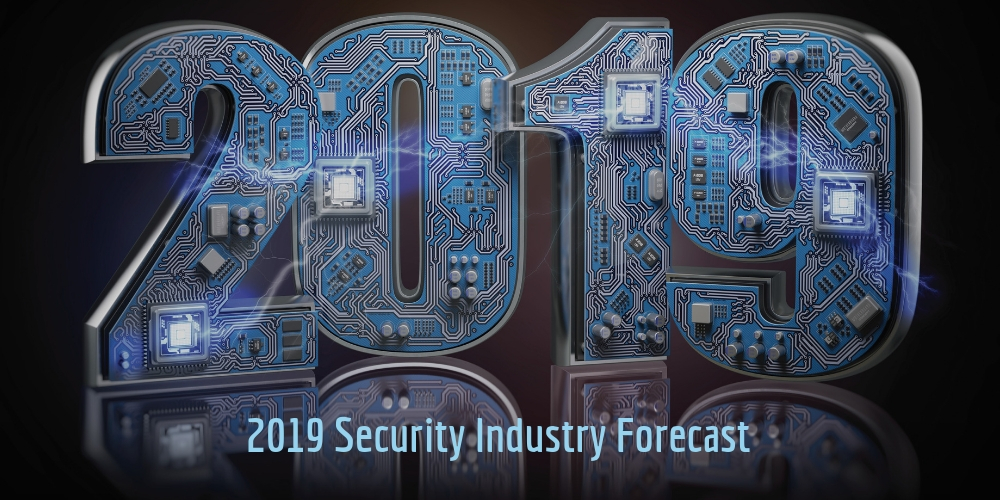2019 Security Industry Forecast: Offering Cloud, IoT Services to Be Imperative
More than a dozen experts weigh in for SSI’s annual forecast, expounding the importance of providing offerings in wireless, smart home, video analytics, managed services and so much more.

Surging advances in technology, customer expectations and competition are spinning the security industry like a centrifuge. Those forces are separating the agile and able from the rank and file, with the former set to seize supersized opportunities.
While protection and prudence have remained vital to the security mission from the very beginning, there is a new ‘p’ word that up until a few years ago would have been viewed by most as contrary to those marching orders. That word is progressive.
Due to breakneck breakthroughs in technology, products and services, coupled with high customer demand and ramped-up competition on all sides, success and growth today requires security dealers and integrators to be nimble and open to change like never before.
Selling security for security’s sake alone remains critical and foundational, but forsaking newer offerings in wireless, mobility, smart home, Internet of Things (IoT), video analytics and artificial intelligence (AI), Cloud, Big Data, managed services and so much more is akin to marketing a model home solely based on its shelter value or a new car because it can transport from point A to point B.
At the same time, providers must acknowledge and address new threats like cyberattacks, active shooter scenarios and DIY solutions.
“As technology changes, physical security systems are increasingly open, and more devices and sensors are connected, bringing cyber risk and data privacy concerns. Cybersecurity — rarely discussed 10 years ago — is now the first thing a client or prospect wants to know,” says Security Industry Association (SIA) CEO Don Erickson. “It is also important, at this pivotal point for the industry, for security companies to embrace change and adapt to meet new consumer needs in as safe and convenient a method as possible. We see firms doing this, for example, with the development of hybrid DIY systems and other consumer-focused offerings.”
Erickson is among the more than a dozen security industry experts and analysts from all channel sectors to lend insights to the annual Security Sales & Integration Industry Forecast.
Caveats and challenges aside, the enthusiasm for 2019’s prospects is universal, with Imperial Capital Managing Director Jeff Kessler anticipating mid to high single-digit growth overall with leading firms generating well into the double digits. National Systems Contractors Association Executive Director Chuck Wilson has an equally bullish outlook.
“We have every reason to believe 2019 will be another strong year,” he says. “All three components of our research including our new financial health index and backlog reports indicate 2019 will be a banner year for integrators … if they can attract, train and retain installers, technicians and system design professionals.”
As the 2010s approach becoming history and a new decade looms, take to heart what SSI’s forecast participants have been kind enough to share. Leverage their vantage points as your advantage to help remain relevant and rally revenues.
2019: Security Technology
Fredrik Nilsson, Vice President, Americas, Axis Communications

Video technology will continue to evolve on all fronts, including advances in low light capabilities and compression technologies. 4K resolution will gain more traction in the market. Features like laser focus and smart IR LEDs will enhance image quality for pan/tilt/zoom cameras.
Improved dewarping, better light sensitivity and higher resolution will increase the popularity of fisheye cameras. And multisensor cameras will become more feature-rich with better image stitching capabilities.
In other IoT arenas, intelligent IP audio systems and IP intercoms will start to supplant a larger share of the market — much like the growth curve in IP video as it supplanted analog solutions — due to the newer technologies’ greater flexibility, higher quality and better total cost of ownership.
On the Cloud front, video as a service will gain momentum, especially for small businesses and enterprise customers with small locations — such as franchise outlets and branch offices. This will be due in part to the greater security of offsite video storage and the ability to access the video remotely on-demand, coupled with the lack of technology and maintenance expertise at customer locations.
The Internet of Things continues to increase user vulnerability to aggressive cyberattacks. Cybersecurity awareness is much higher than even a year ago and integrators and equipment and software vendors are responding more quickly with patches and updates. Although cyber tools will continue to improve in the coming year, it’s always going to be a perpetual race against ever more sophisticated attacks.
Hank Monaco, Vice President of Marketing, Building Solutions North America, Johnson Controls

We’re seeing increased adoption and advancement of video analytics. The technology is becoming easier to use and the insights gained are now more applicable to a broader group of users and operators. This is impacting different use cases, such as the intrusion business.
Video analytics are being leveraged in instances where intrusion technology was previously thought of as the best application. Another use case includes video analytics with access control to understand the movement of people and who is accessing certain areas of the building and when.
It’s also becoming easier to gain access to that information via the Cloud. This is causing both opportunity and concern, which means it’s an area the industry should keep a close eye on as video analytics have great implications for adjacent technologies.
Pierre Racz, President & CEO, Genetec

We anticipate seeing even more unification of systems in 2019. Organizations are already experiencing the benefits of unifying access control systems with video surveillance, and this will only increase. What will also increase is the ability to employ analytics tools to leverage the vast amounts of data that physical security systems and other devices are already collecting.
When organizations are able to understand and leverage their data, they can use it to improve any number of business functions, including efficiency, operations, customer service and revenue generation. Security departments are sitting on a goldmine of data.
Protecting people and assets inevitably involves the collection of personal data, as well as footage of individuals in public spaces and private facilities. To meet the public’s rightful expectations for privacy and the requirements of regulations such as the GDPR and the California Consumer Privacy Act, access to this data or footage needs to be restricted.
However, organizations should not have to choose between protecting the physical security of individuals and their privacy. Hence there will be growing demand for solutions that give organizations complete control over their data to help define who has access to sensitive data and footage and what they can see, without slowing down investigations and incident response.
Richard Ginsburg, President & CEO, Alert 360

There will be continuing demand for consumer automation such as security, IoT devices and integration and the consumer trend toward controlling as many security and automation devices on one app.
We will see more integration with third-party control such as Apple and Google voice control as well as wearables. Artificial intelligence will get better and better, becoming more prevalent in a number of products and services we sell.
There will be a continued demand for video, not only in the commercial market but in residential as well. Smaller companies will find it challenging to adapt to a more complex installation and ongoing support of more robust systems that include more than just security.
2019: Security Markets
John Distelzweig, General Manager and Vice President of Security, FLIR Systems

Smart cities and municipal surveillance projects are driving product innovation requirements for several manufacturers. Similarly, critical infrastructure spending is on the rise as changes in various regulations open up new markets, or regional opportunities, for oil, gas, electric, solar and wind operators.
Also, as more states continue to legalize marijuana in various ways, there is demand in this market for surveillance systems used in “seed to sale” tracking, as well as applications to enhance yields or reduce costs, such as using thermal cameras for radiometric data gathering.
Jorge Hevia, Senior Vice President, Sales & Marketing, Napco Security Technologies

There will be an increasing need for security expertise and requirements from the educational sector for alarms, locking, video, access control and enterprise systems that integrate all.
K-12 and campus administrators, staff, students and stakeholders are largely unfamiliar with security technology, and since there’s no TSA or central governing authority for school security nationwide they are looking for guidance, sometimes in all the wrong places.
They really need the security expertise and technological know-how security pros have as a security dealer, life-safety integrator and/or locksmith.
The key in this market lies in uncovering and closing up access vulnerabilities — controlling initial and continued access through the schools by adding barriers, locks, man-traps, shades, networked access or integrated security management, etc.
Security pros who position themselves as consultant/experts and also offer services/systems will enjoy new networking and business success in the sector. Similarly, healthcare campuses follow this same model, with the exception of less emphasis on alarms.
Ivan Spector, President, The Monitoring Association (TMA)

The residential market might be a tricky place these days, particularly those segments that may be vulnerable to the DIY push. There will still be room for the custom design market, but more of those companies will need to offer all the bells and whistles to a more narrow and focused market that may or may not include private response.
And the same can be said for the commercial market impacted by regulators. Traditional commercial markets like hospitals, care facilities, education and government will still remain robust.
One market that may be undergoing some big disruption is PERS. With apps and geolocation technology, why bother carrying anything else besides a cellphone that can be used in the event of requiring emergency response for assistance?
Bob Harris, President, The Attrition Busters

New technology continuously being pushed out to the public via the DIY channel and others is helping boost market penetration for security like never before. In addition to smart homes, schools, government and healthcare, we now have new opportunities with realtors, auto dealers, caregivers, first responders and lone workers.
There is opportunity for nearly limitless Cloud-based mobile managed services including automation, location-based services, remote access and, of course, an entire bundle of security applications.
The DIY and MIY markets will continue to find ways to disrupt, so our industry would do very well to be proactive and investigate meaningful ways to stand apart by justifying advantages end users will agree with as to why it is far better to pay a little more to get something much better.
At the same time, our industry would clearly benefit to embrace certain DIY offerings utilizing new technology to find new recurring revenue streams.
2019: Business & Operations
Bill Bozeman, President & CEO, PSA Security Network
 Cyber insurance is an area integrators are really focused on right now. We have already heard of some high dollar cyber claims in the last year, so it’s a critical area. Another big challenge and opportunity for integrators is to become managed security service providers.
Cyber insurance is an area integrators are really focused on right now. We have already heard of some high dollar cyber claims in the last year, so it’s a critical area. Another big challenge and opportunity for integrators is to become managed security service providers.
This new business model is based on recurring revenue, so it changes every aspect of the business. Integrators need training on how to sell these types of service packages, adjust how to compensate their sales teams, learn how to properly value their contracts and then work with their lenders on financing.
There will also be a change in the competitive landscape. The players are changing, and I anticipate more IT players making inroads to the security market.
We have already seen a shift in sales strategies the past few years as end-user IT teams are now part of purchasing decisions, and in some cases the sole decision-makers. I anticipate more IT companies adding video and intrusion detection security as value-adds to their clients.
I don’t see them getting into enterprise access systems, at least not yet. But we can expect to see the shift of IT providers adding security to their suite of services.
Chuck Wilson, Executive Director, National Systems Contractors Association (NSCA)

I see a big problem with talent management, training and being able to compensate the technical staff we require to grow the business. Our research indicates that by far the biggest barrier to growth is finding and retaining talent. Overall, security industry integrators simply have to become very IT savvy and do so in a hurry.
We are monitoring more than 100 cybersecurity bills and several that would impact IoT and PoE, and our ability as systems integrators to work with those technologies without a new set of credentials. Many new technologies including machine learning, virtual reality and artificial intelligence will enter into our discussions in 2019.
Keep reading to find out industry expectations for 2019…
If you enjoyed this article and want to receive more valuable industry content like this, click here to sign up for our FREE digital newsletters!

Security Is Our Business, Too
For professionals who recommend, buy and install all types of electronic security equipment, a free subscription to Commercial Integrator + Security Sales & Integration is like having a consultant on call. You’ll find an ideal balance of technology and business coverage, with installation tips and techniques for products and updates on how to add to your bottom line.
A FREE subscription to the top resource for security and integration industry will prove to be invaluable.








